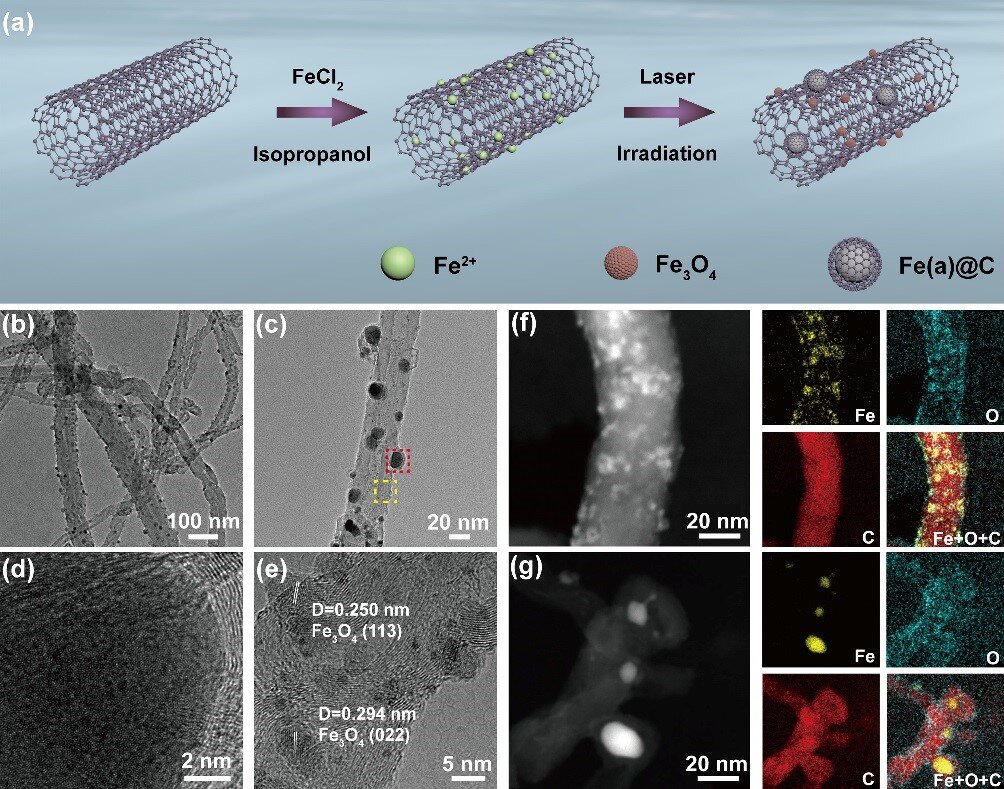Urea (CO(NH2)2) has been applied both in agricultural and pharmaceutical field. The widely used Bosch-Meiser process has high energy consumption and CO2 emission. Therefore, it is imperative to explore energy-saving and economical routes for urea synthesis under mild conditions.
The electrosynthesis of urea with CO2 and NO3– under ambient conditions is an efficient way, but it is far from application. This is because the key step needs an efficient electrocatalyst enabling adsorption and activation of NO3– and CO2 to accomplish the C-N coupling.
Researchers from the Hefei Institutes of Physical Science of the Chinese Academy of Sciences have now developed a liquid-phase laser irradiation route to fabricate symbiotic carbon encapsulated amorphous iron (Fe(a)@C) and iron oxide nanoparticles (Fe3O4 NPs) on carbon nanotubes (denoted as Fe(a)@C-Fe3O4/CNTs).
The as-fabricated Fe(a)@C-Fe3O4/CNTs contained two Fe-based active components, namely, Fe@C NPs with the particle sizes of 10~20 nm and Fe3O4 NPs with the particle sizes of 1~5 nm.
The presence of two different structural units in Fe(a)@C-Fe3O4/CNTs made it possible to synergistically electrocatalytic activate CO2 and NO3– to realize the C-N coupling for urea synthesis.
As expected, Fe(a)@C-Fe3O4/CNTs exhibited superior activity toward the electrocatalytic coupling of CO2 and NO3– for urea synthesis, affording a urea yield of 1341.3±112.6 μg h-1 mgcat-1 and a faradic efficiency of 16.5±6.1% at -0.65 V (vs. RHE) in 0.1 M KNO3 electrolyte.
Both experimental and theoretical results unveiled that Fe(a)@C was mainly responsible for the electrocatalytic reduction of NO3– to form *NH2 intermediates, while Fe3O4 was more beneficial for the electrocatalytic reduction of CO2 to form *CO intermediates.
The synergistically catalytic effect contributes to the excellent electrocatalytic performance of urea synthesis at ambient conditions.
The research was published in Angewandte Chemie International Edition.
More information:
Jing Geng et al, Ambient Electrosynthesis of Urea with Nitrate and Carbon Dioxide over Iron‐Based Dual‐Sites, Angewandte Chemie International Edition (2022). DOI: 10.1002/anie.202210958
Citation:
Ambient electrosynthesis of urea with nitrate and carbon dioxide over iron-based dual-sites (2022, November 25)
retrieved 25 November 2022
from https://phys.org/news/2022-11-ambient-electrosynthesis-urea-nitrate-carbon.html
This document is subject to copyright. Apart from any fair dealing for the purpose of private study or research, no
part may be reproduced without the written permission. The content is provided for information purposes only.
For all the latest Science News Click Here
For the latest news and updates, follow us on Google News.

